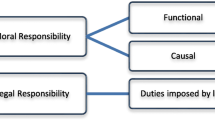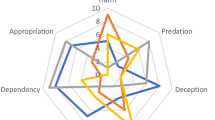Abstract
There are certain kinds of risk for which governments, rather than individual actors, are increasingly held responsible. This article discusses how regulatory institutions can ensure an equitable distribution of risk between various groups such as rich and poor, and present and future generations. It focuses on cases of risk associated with technological and biotechnological innovation. After discussing various possibilities and difficulties of distribution, this article proposes a non-welfarist understanding of risk as a burden of cooperation.
Similar content being viewed by others
Notes
Right-based theories, such as the one defended by Robert Nozick, state that if imposing harm on someone violates their rights, then increasing the probability of that harm by imposing a risk also violates their rights (Nozick 1974, p. 4). Concerning the distribution of responsibility for risk taking, a popular stream of egalitarian theorists, the so-called ‘luck egalitarians’ (Dworkin 1981, 2000; Cohen 1989; Roemer 1996), have recognized the importance of developing theories of justice that are both sensitive to individual choices (for which individuals should be held accountable and responsible) and insensitive to circumstances that are beyond free choice (such as talents, ability, health and natural events). Regulation and public insurance schemes must be designed on the one hand to insulate citizens against the consequences of the natural lottery; on the other hand they should be sensitive to people’s choices. To give an example, in the case of health care this would imply a contributory health insurance system (universal basic health care system) coupled with a private insurance scheme (Dworkin 2000, p. 313).
This is in part because global risks such as global warming and nuclear fission are considered catastrophic for humanity and, in this sense, have an equalizing distributive effect (Beck 1992).
See note 1 above.
Real-life decisions are very often made in conditions of uncertainty (probabilities are either unknown or known with less than full precision). However, most of the time decision-making situations are simplified by treating them as decisions under risk; that is, as cases with known probabilities (Hansson 2003, p. 293).
See Keeton et al. (1984, pp. 534–535) “[i]n all civil acts (…) the law doth not so much regard the intent of the actor, as the loss and damage of the party suffering” so that “[t]here was, in other words, a rule […] that ‘he who breaks must pay’”.
There is an asymmetry insofar as the equality of opportunities offers a chance that one is free to take up or ignore, whilst risk imposes the probability of a negative effect.
References
Abraham, K. S. (1986). Distributing risk: Insurance, legal theory and public policy. New Haven: Yale University Press.
Armstrong, C. (2005). Equality, risk and responsibility: Dworkin on the insurance market. Economy and Society, 34(3), 451–473.
Beck, U. (1992). Risk society: Towards a new modernity. New Delhi: Sage.
Beck, U. (1999). World risk society. Malden, MA: Polity Press.
Caney, S. (2005). Cosmopolitan justice, responsibility and global climate change. Leiden Journal of International Law, 18, 747–775.
Carter, I. (1999). A measure of freedom. Oxford: Oxford University Press.
Cohen, G. A. (1989). On the currency of egalitarian justice. Ethics, 99, 906–944.
Dryzek, J. (1987). Rational ecology: Environment and political economy. Oxford: Blackwell.
Dworkin, R. (1981). What is equality? Part I: Equality of welfare; Part II: Equality of resources. Philosophy and Public Affairs, 10(3), 185–345.
Dworkin, R. (1985). A matter of principle. Cambridge: Harvard University Press.
Dworkin, R. (2000). Sovereign virtue: The theory and practice of equality. Cambridge: Harvard University Press.
Feinberg, J. (1984). Harm to others. New York: Oxford University Press.
Ferretti, M. P. (2007). Why public participation in risk regulation? The case of authorising GMO products in the European Union. Science as Culture, 16(4), 377–395.
Finkelstein, C. (2003). Is risk a harm? University of Pennsylvania Law Review, 15, 963.
Gaskell, G. (2003). Seeds of discontent. Risk and Regulation, LSE, 6, 6.
Giddens, A. (1999). Risk and responsibility. Modern Law Review, 62(1), 1–10.
Gosseries, A. (2007). Cosmopolitan luck egalitarianism and the greenhouse effect. Canadian Journal of Philosophy, 31(suppl.), 279–309.
Hansson, S. O. (2003). Ethical criteria of risk acceptance. Erkenntnis, 59, 291–309.
Harvey, D. (1997). Justice and nature and the geography of difference. London: Blackwell.
Hunold, C., & Young, I. M. (1998). Justice, democracy and hazardous siting. Political Studies, 46(1), 82–95.
Jasanoff, S. (2003). Technologies of humility: Citizens participation in governing science. Minerva, 41(3), 223–244.
Keeton, W., et al. (1984). Prosser and Keeton on torts. St. Paul: West Publishing Co.
May, L. (1987). The morality of groups: Collective responsibility, group-based harm, and corporate rights. Notre Dame: University of Notre Dame Press.
Nagel, T. (1976). Moral luck. Proceedings of the Aristotelian Society, 50 (supplementary volume), 115–135.
Nozick, R. (1974). Anarchy, state, and Utopia. New York: Basic Books.
O’Neill, J. (2001). Representing people, representing nature, representing the world. Environment and Planning C: Government and Policy, 19(4), 483–500.
O’Riodan, T., & Cameron, J. (1994). Interpreting the precautionary principle. London: Earthscan Publications.
Parfit, D. (1997). Equality and priority. Ratio, 10(3), 202–221.
Phillips, A. (1996). Dealing with difference: A politics of ideas, or a politics of presence? In S. Benhabib (Ed.), Democracy and difference: Contesting the boundaries of the political (pp. 139–152). Princeton: Princeton University Press.
Rawls, J. (1971). A theory of justice. Cambridge, MA: Harvard University Press.
Roemer, J. (1996). Theories of distributive justice. Cambridge, MA: Harvard University Press.
Slovic, P. (1987). Perception of risk. Science, 236, 280–285.
Steffek, J., & Ferretti, M. P. (2009). Accountability or “good decisions”? The competing goals of civil society participation in international governance. Global Society, 23(1), 260–287.
Steiner, H. (1993). How free: Computing personal freedom. In A. Phillips-Griffiths (Ed.), Of liberty (pp. 73–89). London: Cambridge University Press.
Thompson, G. D. (1998). Consumer demand for organic foods: What we know and what we need to know. American Journal of Agriculture Economics, 80, 1113–1118.
Waldron, J. (1995). Moments of carelessness and massive loss. In D. Owen (Ed.), Philosophical foundations of tort law (pp. 387–408). New York: Oxford University Press.
Williams, B. (1976). Moral luck. Proceedings of the Aristotelian Society, 50 (supplementary volume), 115–135.
Acknowledgments
I wish to thank the participants in the GARNET workshop on ‘Risk and Responsibility: Theoretical and Normative Issues of Environmental Governance’ at the University of Florence and the political theory seminar ‘Mercoledì filosofici del Maino’ at the University of Pavia. I am especially grateful to Renata Badii, Ian Carter and Filippo Magni for their valuable discussions and suggestions. Thanks also to Carl Cranor, James Holloway, Christian Joerges and Jens Steffek for discussing with me some earlier ideas later developed in this paper, and to the two anonymous referees of this journal for their very useful and constructive comments.
Author information
Authors and Affiliations
Corresponding author
Rights and permissions
About this article
Cite this article
Ferretti, M.P. Risk and Distributive Justice: The Case of Regulating New Technologies. Sci Eng Ethics 16, 501–515 (2010). https://doi.org/10.1007/s11948-009-9172-z
Published:
Issue Date:
DOI: https://doi.org/10.1007/s11948-009-9172-z




